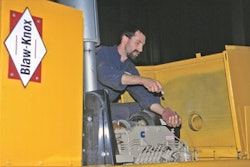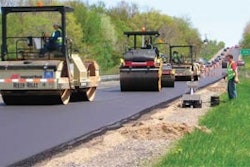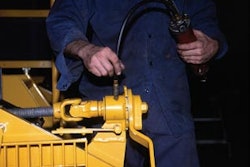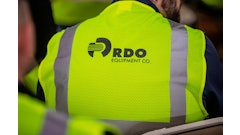
Expansion of the Florida Turnpike in Palm Beach County, FL has reached the midpoint, with Ranger Construction maintaining an aggressive pace to complete the $31 million seven-mile widening project by March 2007. The project includes adding north and southbound travel lanes, reconstructing two bridges and constructing a new shoulder lane that can be converted into a travel lane as future demand requires.
One of Florida's leading heavy/highway contractors, Ranger Construction was awarded the contract to widen seven miles of SR-91 (Florida Turnpike) from Atlantic Avenue to the Lantana Toll Plaza in 2004. The project involves widening the roadway from four to six lanes, milling and resurfacing existing lanes, bridge reconstruction, sound barrier wall construction, drainage, lighting and landscaping. The contract includes up to $1 million in incentives if Ranger finishes work ahead of the 990-day production schedule. Ranger is a major road building, site work, asphalt and excavation contractor serving southeast, central and northeast areas of Florida.
Project on schedule
Juan Hernandez says the project, which began October 2004 is on schedule, with Ranger receiving a $450,000 early completion incentive for meeting the first deadline (covering the southern portion of the project) established by the Florida Department of Transportation. Completion incentives/disincentives assess a daily amount of $6,000 for the southern phase of the project and a daily amount of $3,665 for the entire 990-day completion deadline. Work on the project includes adding a travel lane to the existing two travel lanes of both the north and southbound sections of the turnpike, as well as constructing a full-depth outer shoulder to accommodate future travel lane needs. The expansion also includes milling the existing travel lanes to correct cross slope of the expanded highway and repaving those lanes. Hernandez estimates that over 320,000 yards of old asphalt will be milled from the existing travel lanes, shoulders and on/off ramps during the project.
"We had to trench out the (additional) third lane and shoulder to subgrade and then build those two lanes up to the existing travel lanes," Hernandez says.
Hernandez expects to complete work on the project by the March 2007 deadline and collect another $550,000 incentive by beating the 990-day project schedule. There are additional incentives Ranger can achieve for density and value-added pavement specifications. While there have been some changes during the first phase of the project, the only significant anticipated overrun on the original $31.3 million contract is an FDOT-approved design change to add guardrails to sections of the roadway that didn't already have the safety structures, which will add approximately $200,000 for 9,000 feet of installed guardrail.
The FDOT contract did allow for a percentage of reclaimed asphalt pavement (RAP) to be used on the project, with Ranger required to assume full responsibility for the design and construction of asphalt mixes which incorporate RAP as a component material. With all mix designs used on the project, Ranger is responsible for establishing accurate specific gravity values. On the Traffic Levels D and E mix designs, which were specified for the turnpike project, Ranger is not permitted to use more than 30 percent RAP; and for Traffic Levels A, B and C designs, the RAP content cannot exceed 50 percent by weight of total aggregate. In any mix design using a PG 76-22 Asphalt Binder, RAP content is limited to a maximum of 15 percent. All RAP used in the project must also have a minimum average asphalt content of 4 percent by weight of total mix. Roadway testing requirements for density of the compacted mix designs require Ranger to pull a minimum of five 6-inch cores within 24 hours of placement at random locations as directed by FDOT's engineer within each sublot.
Value Added Asphalt
Upon completion of the project, Ranger is required to warranty its work and the quality of pavement it placed under FDOT's "Value Added Asphalt Pavement" specifications. The warranty covers both the asphalt concrete structural course and the asphalt concrete friction surface course. Remedial work covered by the warranty includes:
- Rutting — Remove and replace the distressed areas to full depth of all layers and full lane width.
- Ride — Remove and replace the friction course for the full length and the full lane width of the distressed area.
- Cracking — Remove and replace the distressed area to the full depth of all layers and to the full lane width.
- Raveling and/or delamination affecting the friction — Patch the distressed area to the full distressed depth and to a minimum surface area of 150 percent of each distressed area.
- Pot holes and slippage areas — Remove and replace the distressed area to the full distressed depth, and to a minimum surface area of 150 percent of each distressed area.
- Bleeding — Remove and replace the distressed area to the full distressed depth, and to a minimum surface area of 150 percent of each distressed area.
Ranger is not responsible for remedial work under the warranty if it is determined that:
- The original pavement design thickness is deficient.
- The Accumulated ESALs (Equivalent Single Axle Loads) in the design lane have increased by 25 percent or more over the Accumulated ESALs used by FDOT for design purposes for the warranty period. In calculating ESALs, the Average Annual Daily Traffic (AADT) will be obtained from the Department's traffic count data and the T24 (Percent Heavy Trucks during a 24 hour period) will be obtained by the Department's traffic classification survey data.
- The deficiency was due to the failure of the existing underlying layers that were not part of the contract work.
- The deficiency was the responsibility of a third party or its actions, unless the third party was performing work included in the contract.
Long-lasting flexible pavement
Hernandez is confident the approximate 108,000 tons of new hot mix asphalt (HMA) placed on the turnpike expansion project will meet all warranty requirements outlined by the FDOT contract. The new travel lane and full-depth shoulder lane is constructed on a stabilized 12-inch subgrade. Approximately 10.5 inches of lime rock base was placed on top of the stabilized subgrade prior to placement of the new asphalt roadway.
The two 2-inch structural asphalt lifts were constructed with a Traffic Level D mix design at 440 pounds per square yard (based on a 4-inch thick pavement) using a 12.5mm nominal aggregate. The two structural lifts were follwed by a 1.5-inch Traffic Level D course consisting of PG 76-22 polymer modified asphalt binder at 150 pounds per square yard using a 12.5mm nominal aggregate and a ¾-inch open-graded friction wearing course (FC with rubber additive) applied at 80 pounds per square yard.
On the milled existing travel lanes, a new 1.5-inch structural Level D polymer modified overlay was placed, followed by the ¾-inch open-graded friction course.
Ranger's paving crew used a Roadtec RP190 paver to place the various lifts on the project, along with several Hypac C 778B, Ingersoll Rand and Caterpillar rollers to achieve compaction.
"Our crews have been doing a great job placing the different mix design and achieving the compaction density required," Hernandez says. "When we're finished, FDOT will have a very good, long-lasting pavement that will handle the projected traffic volume increases it was designed to handle."















![Lee Boy Facility 2025 17 Use[16]](https://img.forconstructionpros.com/mindful/acbm/workspaces/default/uploads/2025/09/leeboy-facility-2025-17-use16.AbONDzEzbV.jpg?ar=16%3A9&auto=format%2Ccompress&fit=crop&h=135&q=70&w=240)




